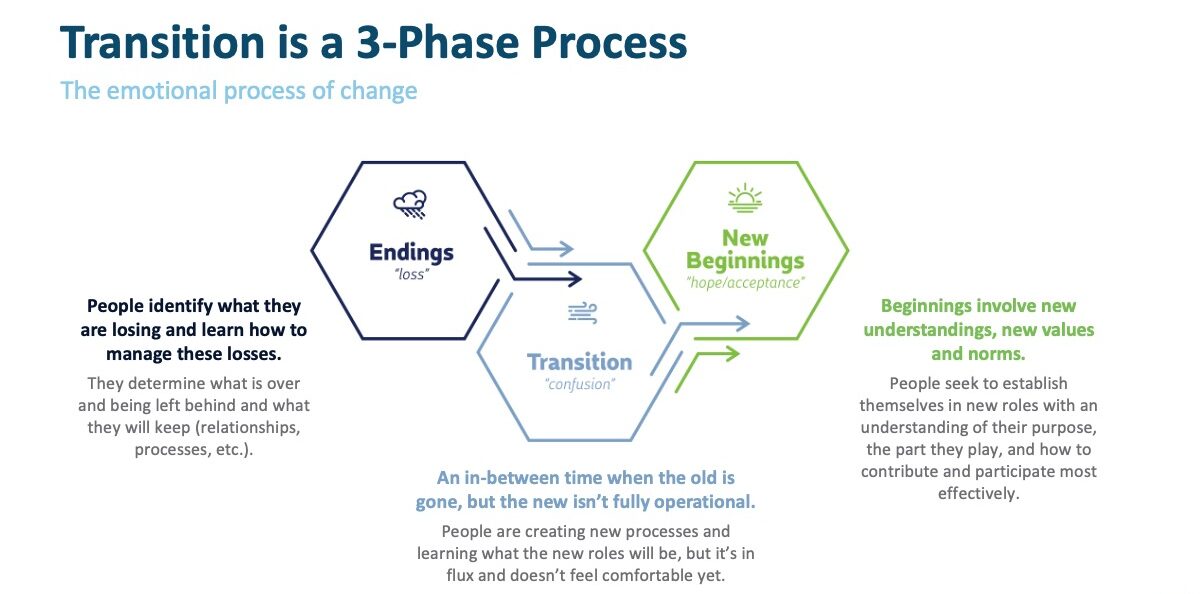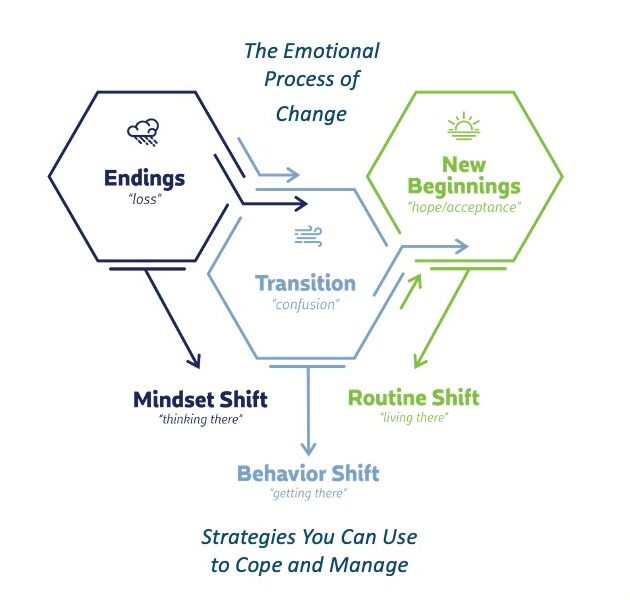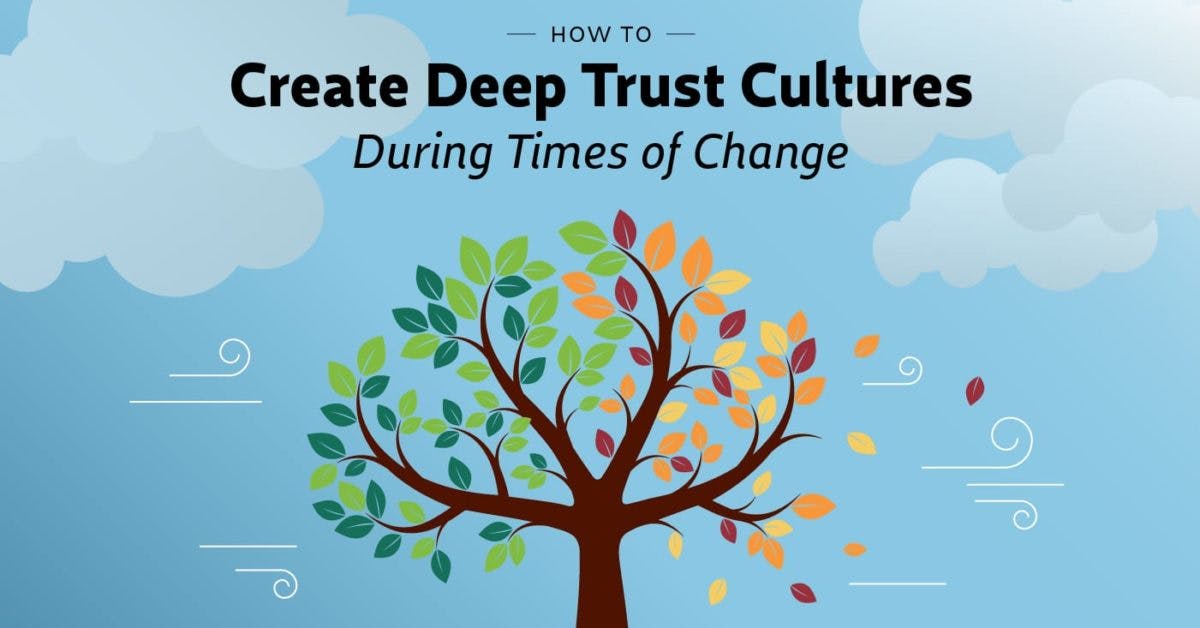How Leaders Can Help Employees Deal With Change in the Workplace
As a leader, it’s your job to help employees navigate times of uncertainty and change. While changes are often external events — such as mergers, re-orgs, and culture transformations — changes spark an internal process for employees that is both emotional and psychological. As a leader, you can’t control how your team will react to the change, but you can learn to recognize how your employees are feeling about the transition — and how you can best support them through it.
Let’s discuss how employees process organizational change and how you and your fellow leaders can support them through the transition.
How Employees Experience Change
Before we can discuss how to manage your employees through change, it’s important to understand how people psychologically process change. Employees experience different emotions as they move through this transition process. Employees will transition from feeling a sense of loss, to feeling some confusion, then finally — with your support and change leadership — feeling a sense of acceptance and commitment.
We break this process down into three steps: Endings, Transition, and New Beginnings.
- Employees start at Endings, where they will grapple with what they leave behind while coming to terms with change initiatives.
- During the Transition phase, employees feel conflicted by the old way of thinking or doing that is being replaced with a new way that may not be fully functional or feel comfortable just yet.
Last, employees who receive proper support from their leaders will reach New Beginnings. In this phase, employees are fully committed to and accept the change.

Understanding the Change Process
Change is a process. Although the change event itself may happen in an instant, the transition happens over time. Adjusting to change starts with a mindset shift, then a behavior shift, and finally, a system and routine shift.
- Mindset Shift: When employees first hear about the change and begin to wrap their heads around what they might have to give up and what their “new normal” is.
- Behavior Shift: When employees begin to take steps toward the “new normal” and make a conscious effort to develop behaviors that will support this.
System and Routine Shift: When new operating models / systems, ways of working, and processes are all formalized and employees begin to operate in the “new normal.”

How to Support Employees Through Change
Understanding how change transitions work and how employees emotionally process change allows leaders to provide the support their teams need during critical times in their organizations. Next, we’ll discuss how you can best support, manage, and lead your people through work transformations.
Identify Which Phase of Change Your Employee Is Experiencing
Your first steps as a leader are to identify what stage of the transition your employees are in and alter your leadership style to fit their needs, identify the behaviors that need to change, reinforce these behavior changes as you see them, and communicate openly with your team as the transition takes place.
Not every employee or team will move through these phases at the same pace. Some may have already reached a feeling of commitment or acceptance, while others may still be wrestling with the feeling of loss and are working through the mindset shift.
So, how can you identify which phase of the change your employee is in? Listen carefully to what they are saying. While it will vary based on the change your organization is undergoing, here are some examples of language that can reveal what phase of the change your employee is currently in:
Mindset Shift / “Loss”
- I want to keep doing what I was doing before
- I liked the other people I was working with before
- The way things have always been done is fine
- I have to learn new things now
- I wasn’t done yet
- My time and energy has been wasted
- I need to change my entire process and approach
- This is a bad idea
- This won’t work
Behavior Shift / “Confusion”
- What’s going to happen to the old stuff?
- What else will change?
- Will I be replaced?
- How is this new stuff going to work?
- How will this happen?
- Do we have the skills and resources to do this?
- This is hard to figure out
- I don’t know how to navigate this
System and Routine Shift / “Acceptance and Commitment”
- These new ways have potential
- I’m ready to learn and try something new
- There are new opportunities now
- I get to build new relationships
- I can see how this will be better for the future
Identify the Behaviors That Need to Change
As a leader, your responsibility in times of change is to model the change behaviors your employees should display moving forward. That starts with pinpointing the behaviors that need to change and reinforcing these behavior changes as you see them.
As employees first come to terms with change, their feelings of loss can stand in the way of accepting the change with the right behaviors. Fortunately, there are a few strategies you can use to demonstrate desired behaviors and start holding individuals to those expectations:
- Guide employees to take responsibility for specific roles they play in the change
- Be open, transparent, and willing to listen
- Alleviate concerns, reduce unnecessary worry, and encourage patience through the process
- Establish clear expectations and ensure managers and other leaders enforce them as well
Again, you should think about how to best move people toward a new change behavior and mindset by meeting them where they are in their change journey. For instance, employees who are at the start of their change journey benefit from leaders who coach them toward new behaviors by asking them the right questions. What are you holding on to, and what should you let go of? What are you scared of losing, and what do you stand to gain?
Communicate, Communicate, Communicate
Once you can map out where your employees are in their change acceptance journey, you can craft strategic communications that unify your people and resonate with their feelings. Clear communication is a vehicle for establishing a Deep Trust and High Expectations® culture among you and your employees — it answers their questions, acknowledges their concerns, and assures them of the plan moving forward.
Leaders should keep the following in mind to effectively communicate through change:
- Share the “why.” Gaining employee buy-in starts with crafting a persuasive “why” behind the change. Employees are more likely to uphold change initiatives when they understand the reasons for making the decision, and hearing it from the source will cut down on rumors and misinformation.
- Set timelines and expectations. In times of uncertainty, leaders can rally their employees through change by staking out clear timelines, responsibilities, and expectations. Keep in mind that change doesn’t happen overnight, and people will need time to process and accept this new direction. Be as prescriptive as possible as you explain what is changing and when these changes will take place.
- Solicit feedback. Empower your employees to feel like they are part of change efforts by offering platforms for them to share their thoughts, concerns, and questions. In turn, make sure you ask questions of your own to your people.
- Layer in compelling visuals. A robust internal communications strategy incorporates more than one communication channel. Visual communications are highly effective during change initiatives because they articulate a clear vision for the future, summarize key points, and outline how your organization will reach its future state.
Lead with Empathy
Leading with empathy is key to guiding your employees, fellow leaders, and entire organization through critical turnpoints in your business, and it connects the emotional journey your employees are navigating to the outcomes you are driving toward.
Here are a few actions you can take to demonstrate empathetic leadership:
- Acknowledge previous accomplishments. Your people may deflate when they hear that the old processes they used — sometimes to great success — will be no more. Motivate and inspire your employees by acknowledging all the incredible work they’ve done in the past, and assure them that there is even more excellent work to be done within these new systems.
- Practice deep listening. Empathy requires putting yourself in your employees’ shoes. To do that adequately, you need to really listen to what your teams have to say. When your employees voice their opinions, leverage deep listening skills by avoiding interrupting, removing your initial judgments, and asking thoughtful follow-up questions in response.
- Stay self-aware. Self-awareness gives leaders the ability to evaluate their own role in change initiatives, keep their own emotions in check, and let their teams know that they’re human too. More likely than not, you won’t have all the answers — and that’s okay. Staying aware of how you’re feeling, what you do know, and where your own shortcomings lie will make you a leader worth rallying behind.
Final Thoughts
As a leader, it’s important to be aware of how your employees are truly feeling during times of transition in order to effectively support them and lead them through the change. By having a clear vision of where your employees are emotionally in their change journey, you’ll be better situated to help them reach New Beginnings and come to work with the mindsets, behaviors, and systems that are necessary to propel your organization forward.
If you’re embarking on your next organizational shift or are grappling with the effects of a recent change initiative, we have the tools to help your team manage uncertainty and unify them toward a new direction. Our Navigating Change Workshop provides managers, groups of individuals, and intact teams with an in-depth look into how organizational change works and how to empower teams for success.
Still have questions? Get in touch with our team.
(Based on the William Bridges Transition Model)








